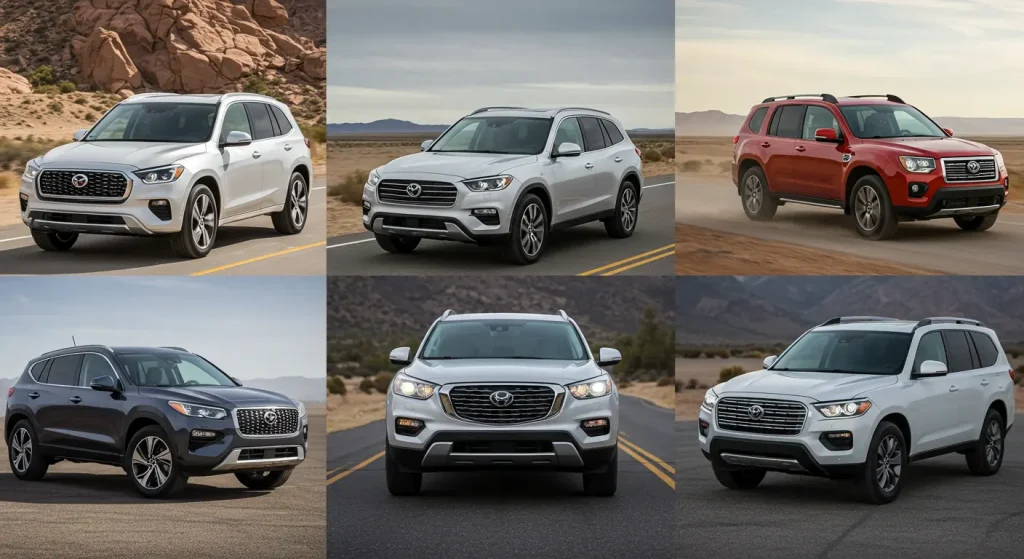Best SUVs Without CVT Transmission | Drive with Durability
Over the years, more car manufacturers have incorporated the design and production of SUVs into their lines due to the increased demand. Today, there are many vehicles on the market with CVTs, but the tendency reveals that more and more drivers prefer cars with shift transmissions for the sensation of driving, reliability, and control.

Best SUVs Without CVT Transmission
This guide is specifically designed to uncover the best SUV cars without CVT transmission along with the reasons why you might wish to go for one of these vehicles for your next wheels.
Why Choose an SUV Without CVT Transmission?
There are several reasons why drivers prefer SUV cars without CVT transmissions. Performance for a car with a CVT is characterized by smooth, graceful acceleration, and increased fuel economy, but for some drivers, these advantages cannot compensate for the disadvantages. Conventional automatic or manual transmissions usually offer more fun, better handling and control, and, at times, greater longevity.
Reasons to Consider an SUV Without CVT:
Driving Dynamics
Automobiles with traditional hydraulic (automatic or manual) transmissions offer drivers a more mechanical and thus fuller feel behind the wheel, which is beneficial for serious trail-driving or track-time.
Durability and Longevity
On average, a CVT is not as durable as its gear-based transmission counterpart, and this means costly repairs could be needed at some point.
Better Control
Most drivers think a manual transmission is more controllable than an automatic one, particularly when driving on steep inclines or while towing.
Analyzing the Differences Between CVT and Traditional Transmissions
What is a CVT Transmission?
CVT stands for Continuously Variable Transmission. It is a type of automatic transmission that does not use set gear ratios like standard automatics. Instead, a CVT system uses a belt and pulley mechanism to enable smooth transitions through speed ratios.
Pros of CVT:
- Smooth acceleration
- Better fuel efficiency
Cons of CVT:
- Lack of control and driving feedback
- Durability issues and costly repairs
- Less effective for towing
How Traditional Transmissions Work
In conventional transmissions, there are fixed gears that the car shifts through while accelerating or decelerating. Manual transmissions involve driver input, while automatics shift gears based on vehicle speed and road conditions.
Benefits of Traditional Transmissions:
- Greater control over gear changes
- Proven durability, especially in tough terrains
- More engaging driving experience
Top Best SUVs Without CVT Transmission
Here are the best SUV models without CVT transmissions, with detailed information on performance, efficiency, and safety features:
1. Toyota RAV4
- Transmission: 8-speed automatic
- Fuel Efficiency: Up to 35 mpg (highway)
- Safety Ratings: Excellent crash test results; includes Toyota Safety Sense
- Features: AWD available, spacious cargo, user-friendly tech
2. Ford Bronco
- Transmission: Manual or 10-speed automatic
- Performance: Multiple engines, including turbocharged V6
- Fuel Efficiency: 17-22 mpg depending on the model
- Safety: Strong off-road capability, decent safety features
3. Jeep Wrangler
- Transmission: Manual or 8-speed automatic
- Performance: V6 engine, robust off-road features, 4WD optional
- Fuel Efficiency: Up to 25 mpg (highway)
- Safety: Solid build, though lower crash test scores
4. Chevrolet Equinox
- Transmission: 6-speed automatic
- Performance: 1.5L turbocharged engine
- Fuel Efficiency: Up to 31 mpg (highway)
- Safety: Lane-keeping assist, forward collision warning, high safety ratings
5. Hyundai Tucson
- Transmission: 6-speed automatic
- Performance: 2.5L four-cylinder engine
- Fuel Efficiency: Up to 33 mpg (highway)
- Safety: Advanced safety suite, high crash test ratings
6. Kia Sportage
- Transmission: 6-speed or 8-speed automatic
- Performance: 2.5L engine, AWD available
- Fuel Efficiency: Up to 30 mpg (highway)
- Safety: Top safety ratings, many standard features
7. Mazda CX-5
- Transmission: 6-speed automatic
- Performance: Optional turbocharged engine, sharp handling
- Fuel Efficiency: Up to 31 mpg (highway)
- Safety: Strong safety features and crash ratings
8. Porsche Cayenne
- Transmission: 8-speed automatic
- Performance: V6 and hybrid options
- Fuel Efficiency: Around 22-24 mpg (combined)
- Safety: Premium safety tech, excellent crash performance
9. 2024 Mercedes-Benz G-Class
- Transmission: 9-speed automatic
- Performance: Twin-turbo V8 engine
- Fuel Efficiency: About 17 mpg (combined)
- Safety: Adaptive cruise control, emergency braking
10. Toyota Highlander
- Transmission: 8-speed automatic
- Performance: 3.5L V6 engine
- Fuel Efficiency: Up to 29 mpg (highway)
- Safety: Top safety scores, standard driver-assist systems
Things to Consider When Choosing an SUV Without CVT
Driving Style and Comfort
If you enjoy being more involved with gear shifts and overall car control, a traditional transmission is ideal.
Budget and Maintenance Costs
While traditional transmissions tend to last longer, maintenance can be more involved. Ensure you consider long-term ownership costs.
Resale Value and Longevity
Vehicles with traditional transmissions often enjoy better resale value and longer lifespans, especially if maintained well.
Conclusion
Choosing the best SUV without CVT transmission allows drivers to enjoy a more engaging and reliable driving experience. Whether you value off-road prowess, family-friendly comfort, or luxury performance, there is a non-CVT SUV out there for you.
From rugged trail beasts like the Jeep Wrangler and Ford Bronco to refined performers like the Porsche Cayenne and Mercedes G-Class, these SUVs avoid the complexity of CVTs while offering dependable driving performance.
Carefully evaluate your driving needs, budget, and long-term goals before deciding on the best non-CVT SUV for you.
Also Read: Taipei Self Driving Gharry
FAQs
What is the advantage of an SUV without a CVT?
A more engaging driving experience, improved towing and off-road performance, higher reliability, and often better resale value.
Are there any downsides to choosing a traditional transmission?
Possible lower fuel efficiency, a more complex driving experience in traffic, and higher repair costs in some scenarios.
How do these SUVs compare in terms of reliability?
Models like the Toyota RAV4 and Hyundai Tucson are known for strong reliability. Off-road-focused models like the Ford Bronco and Jeep Wrangler also perform well but may vary by model year. Always check specific reliability data.